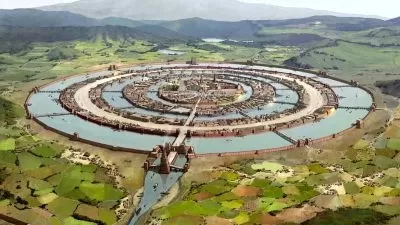Tibet: History, Culture, and Religion
Constance Kassor
8:49:21
Description
There are few regions that have been more misunderstood by the West than Tibet. It is still often portrayed in the West as the “Shangri-la” that was described in the 1933 novel Lost Horizon, one of the earliest references to Tibet in English-speaking culture. It is often envisioned as a mystical place full of happy, meditating monks and carefree nomads who use Tibetan singing bowls for healing and comfort and The Tibetan Book of the Dead to guide their journey from this life. But while the singing bowls are now ubiquitous in Tibetan tourist shops, scholars can find no original connection to Tibetan culture. And The Tibetan Book of the Dead that influenced so many Westerners in the 1960s and 1970s, from Carl Jung to the Beatles? Scholars, today, describe it as not Tibetan, not a book, and not about death.
In Tibet: History, Culture, and Religion, Professor Constance Kassor, will show you the real, multi-dimensional Tibet and its people who live on the “Roof of the World,” the highest and largest plateau on Earth. In 24 fascinating lectures, you will learn how Tibet’s history was shaped by kings and kingdoms, power struggles, religion, traditions, and wars and peace. Today, geopolitical struggles, modernism, and the exile of its religious leaders form an existential threat that few other regions face: This is the real Tibet.
What Is Tibet?
Unlike most regions, even a definition of Tibet depends on who you ask. Is it an independent country with its own long history? Is it a region of the world that has been under Chinese influence for centuries? Is the whole of Tibet contained in the current Tibetan Autonomous Region created by China in the 1950s? Or does Tibet include the entire plateau, northern side of the Himalayas, and the areas formally annexed into China? What about the current Tibetan leadership in exile in Dharamsala, India? What are the legitimate borders of Tibet—and who has the authority to say what they are?
These and many other questions are examined in Tibet: History, Culture, and Religion as Professor Kassor takes you through the varied and complex history of this fascinating region. As you learn about the complicated political and cultural dimensions of Tibetan history, you will engage with the region and its people, including:
- Lifestyles. Many Tibetans have lived as nomads for thousands of years, playing an important role in the creation of the Silk Road about two centuries before the Common Era. Today, many are nomads, farmers, or have combined the two—although the Chinese government has made these lifestyles more challenging.
- Food. Given that vegetables are so difficult to grow at such altitude, meat and animal products are the most important dietary staples. You’ll learn about yakmo milk, butter, cheese, and yogurt, and the national delicacy of momo dumplings.
- Festivals. The one holiday that is celebrated almost universally by Tibetans is Losar, the Tibetan New Year. Although it has traditionally been two weeks of celebration, it has recently been used as a time to protest Chinese authoritarian rule. While protests per se have been outlawed in Tibet, Tibetans protest quietly by not celebrating the holiday.
Tibetan Buddhism
More than 2,500 years ago, a prince named Siddhartha Gautama lived in today’s northern India and Nepal. Raised with every luxury, he left his palatial life as a young man to pursue the spiritual life, searching for a way to rid the world of suffering. Eventually, he became enlightened, and, for the rest of his life, he taught the philosophy he had discovered. He was known as the Buddha, the Awakened One. Today, more than 500 million people follow his teachings and practice Buddhism worldwide.
Buddhist teachings made their way to Tibet, influencing nearly all aspects of Tibetan life. Tibet’s alphabet and grammatical system are derived in part from Buddhist-influenced scholasticism in India. Over the centuries, Tibetan Buddhism developed a distinct tradition all its own, reflecting the influences of India and China, as well as the area’s Indigenous religious traditions such as Bön.
To better understand the importance of Tibetan Buddhism in the history and culture of the entire region, Professor Kassor will lead you through topics such as:
- The Great Dharma Kings. Buddhism flourished when Tibetan kings encouraged and supported the practice. Those who are most remembered for helping to establish Tibetan Buddhism are Songtsen Gampo, Trisong Detsen, and Ralpachen. But these men were not gods, and you will learn how the dissemination of Buddhism was influenced by their earthly loves, scholastic interests, and the specific teachers they chose to bring from India.
- The Practice of Merit. Merit is a type of spiritual good fortune that can help Tibetan Buddhists along their religious path both in this life and the next. Two of the most common merit-making activities for Tibetan Buddhists are circumambulations, walking around holy places, and prostrations.
- Sutras and Tantras. Tibetan Buddhist teachings and practices can be divided into sutras, instructions that can be taught to any practitioner, and tantras, philosophically complex, esoteric teachings that are usually only shared with highly trained and skilled meditators.
The Dalai Lama
Even most people with little real knowledge of Tibetan history or religion are familiar with images of Tibet’s long-time leader, the fourteenth Dalai Lama. Although he humbly describes himself as a simple Buddhist monk by the name of Tenzin Gyatso, his role in Tibetan history, even world history, reveals a man who came to be the political and spiritual leader of his people at a very difficult and challenging time. In Tibet: History, Culture, and Religion, you will learn about the significant role he has played with respect to:
- The Government of Tibet. The fourteenth Dalai Lama assumed his office as the formal leader of Tibet at age 15 in 1950, just one month after the People’s Republic of China sent troops into Tibet to “peacefully liberate” the country. In 1959, the Dalai Lama and thousands of Tibetans were given asylum in India, and the Dalai Lama began leading the Tibetan government in exile.
- World Peace Efforts. As leader of Tibet, the Dalai Lama proposed a Five-Point Peace Plan for Tibet that was rejected by China. In 1989, he was awarded the Nobel Peace Prize for his long-time, non-violent struggle for the liberation of Tibet.
- Future Dalai Lamas. In 2011, the Dalai Lama formally transferred his political leadership to a democratically elected leader, while retaining his spiritual leadership. Since China has formally outlawed the practice of reincarnation, it is unclear whether Tibet will see a 15th or subsequent Dalai Lamas.
With Professor Kassor as your guide, you will gain an understanding of the very real issues facing Tibet today, as opposed to the Tibetan stereotypes the West has often clung to. Will Tibet survive through the 21st century and into the future? At this time, the future is uncertain; this course will help you understand what is at stake.
More details
User Reviews
Rating
Constance Kassor
Instructor's CoursesConstance Kassor is an Associate Professor of Religious Studies at Lawrence University, where she teaches courses on Buddhist thought and Asian religious traditions. She earned her PhD in Religious Studies with a concentration in West and South Asian Religions from Emory University. She has spent several years living with Tibetan Buddhist communities in India and Nepal. Her research has been supported by grants from the Fulbright Program, the National Endowment for the Humanities, and the Khyentse Foundation.

The Great Courses
View courses The Great Courses- language english
- Training sessions 25
- duration 8:49:21
- English subtitles has
- Release Date 2023/10/02
















